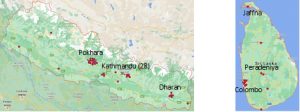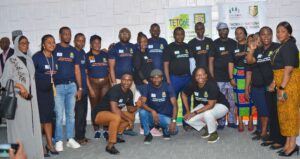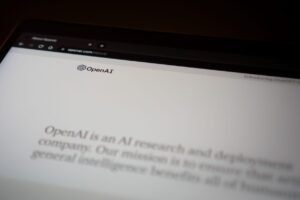
Stronger national journal publishing increases research relevance
The publishing strand of our Global Platforms for Equitable Knowledge Ecosystems supports journals in low- and middle-income countries with improving their publishing processes to support greater research impact in the countries. Sioux Cumming explains.
“Publish or perish” is often seen as the golden rule of academic excellence, but how do we ensure that publishing opportunities are equitable in an unequitable world?
Over the past two decades, Journals Online platforms have been established with national and regional partners to address the challenges of visibility and perceived credibility that many Southern journals face. Journals Online platforms first increased visibility of Southern journals by providing an online home for these journals, often for the first time, and helping them become discoverable. Over time, as these platforms – in Africa, then in southern Asia and Central America – became more established, they shifted to local management. As this happened, INASP’s role shifted to addressing the perceived credibility challenge for many Southern journals by supporting the quality of journal publishing processes.
This is where the publishing strand of INASP’s Sida-funded Global Platforms for Equitable Knowledge Ecosystems (GPEKE) programme comes in. GPEKE helps improve equity in research and knowledge by supporting researchers in communicating their research and in strengthening the channels that exist in the South for sharing research finding.
The GPEKE programme builds on the foundations of global platforms, such as the AuthorAID project, the Journals Online platforms and INASP’s Moodle platform for online courses, to address inequities at a global level. However, it also focuses in on the inequities that can exist within countries, in particular around gender, career stage and where within a country people live.
Why equitable knowledge systems matter
National journals are very important in the research system. They help to ensure Southern voice in knowledge production. And our experience suggests national journals are more likely to publish materials relevant to the research agendas and development issues within those countries rather than responding to international research priorities. In this way, they allow a more diverse and equitable range of authors to publish their research in journals that are more easily accessible to the audiences most likely to use that research.
Support to journals through the GPEKE project across the South enables Southern journals to follow and respond to global challenges and expectations – and this is helping research from more diverse geographies and research areas to be discoverable and make a difference to development.
The drive to strengthen Southern-led publishing has to begin by acknowledging that research can’t only come from the ‘usual suspects’ – the big institutions which already have the systems, frameworks and reputational clout to access mainstream publications. Instead, emphasis has to be made in ensuring that research from the South also represents the diversity and breadth of the countries it comes from.
Improving publishing processes
As part of GPEKE, INASP offers training courses for editors and their editorial boards via INASP’s Moodle platform. This training is designed to equip editors to improve their publishing practices and meet the criteria set up by the Journal Publishing Practices and Standards (JPPS) framework, which African Journals Online and INASP launched in 2017.
Across the Journals Online platforms in Asia the impact of improvements to journal processes has been reflected in recognition by international indexes. One example is Mongolian Journal of Chemistry, which is a two-star journal on JPPS and last year began to be indexed in Scopus. Other journals in the JOLs have recently been added to CAB Abstracts. The role of the JPPS process for evaluating journal publishing practices within countries has also been recognised in Nepal where publishing in a journal with JPPS stars is now part of the University Grants Commission’s promotion criteria for academic staff.

Map of new journals that joined JOL platforms in Nepal (left) and Sri Lanka (right) in 2020
It has also been inspiring to see the locally managed JOLs improve the diversity of the journals in their portfolio. In the early days of the JOLs there was significant clustering of journals in the capital cities and in subject areas like science, technology, engineering and medicine. In recent years we have seen a shift; in Nepal and Sri Lanka, in particular, the journals are now published throughout the countries. And the platforms now include more diverse subject areas, including more business, management and literature titles.
Country focus
This editor training is available to journals on all the Journals Online platforms. However, as part of GPEKE’s more in-depth focus in selected countries, there is particularly support to journals in Ethiopia and Uganda as a result of partnerships with the Ethiopian Academy of Sciences (EAS) and the Uganda National Council for Science and Technology (UNCST). These partnerships support partner-led country platforms to showcase national research outputs – from across the two countries – by ensuring these outputs are not only easily available but meet the minimum criteria for journal publishing. The partnerships emphasise and support sustainability through strong local ownership by government and national-level bodies.
The Ethiopian Academy of Sciences has already been doing a lot of work to improve the quality of the journals published in Ethiopia. In 2019, the Ministry of Science and Higher Education (MoSHE) issued a Directive on Establishing and Implementing a National System of Journal Evaluation and Accreditation. EAS was then mandated to implement the evaluation process with a very comprehensive list of criteria. The evaluation process began in 2020, but because of the pandemic the work was slower than expected and some of the support activities which INASP had planned were not possible. Since mid-2020, 32 journals have been evaluated and 16 of them have been accredited by MoSHE. In 2021 a similar number of journals has been submitted and EAS is in the process of reviewing them.
UNCST has taken a slightly different pathway, with efforts currently underway to set up a repository for national research outputs and a website for the journals published in the country. The global pandemic has created a great opportunity for UNCST to develop its own plan to showcase its national research outputs, using its own developers so that UNCST has full ownership from the start. This is providing the opportunity for INASP to play an advisory role to support Southern-led institutionalisation of publishing capacity.
What lies ahead?
Online journal platforms are important because they allow researchers in smaller institutions to have a voice, and an institutional journal becomes an important stepping-stone in that process. Through GPEKE, INASP and partners will continue to create an enabling environment to ensure that the approaches honed over several years at an international scale are being incorporated into publishing approaches in Uganda and Ethiopia in a more tailored way to meet the local needs and international standards.
Cover photo: Journal editor Alexander Odaibo from University of Ibadan, Nigeria, pictured taking one of the modules of the editor course in 2020 in the Zoological Garden near where his journal office is located

 Previous Post
Previous Post Next Post
Next Post


